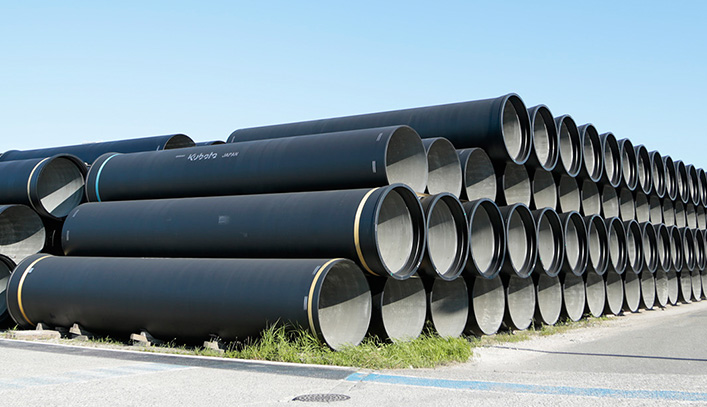02
Steady Supply of Safe Water Needed Urgently
- Karnaphuli Water Supply Project, Chattogram -

Bangladesh - An emerging country in South Asia achieving striking economic growth
Located in South Asia, the People’s Republic of Bangladesh is home to the Ganges River, which pours into the Bay of Bengal. For its abundant crops made possible by its rich water resources, this region was once touted as the “Golden Bengal.” Since that fertile time, the national economy stagnated, temporarily bringing the country to the last position in the list of less-developed countries in Asia. This has been due to inadequate infrastructure as a result of social confusions in the latter half of the last century, including regional conf licts and independence movements, as well as inefficient government. This unfortunate situation changed positively since the turn of the new century, with the nation’s economy recording 7.24% growth in fiscal 2017. Now, like many other countries in Asia, Bangladesh is counted among the fast-emerging economies. Behind this remarkable growth is the apparel industry, which accounts for over 80% of the country’s exports, making Bangladesh the world’s second largest exporter of clothing after China. With a population of approximately 160 million, Bangladesh is the eighth most populated country in the world. This huge population makes Bangladesh attractive both as a labor market and a consumption market, and the world has been looking intently at the country in recent years.
To express the water related problem of Bangladesh simply, the lack of steadily supply of safe water. Located in a subtropical zone, Bangladesh has an ample volume of water thanks to rainfall during the rainy season, yet the quality of its groundwater— the country’s major source of water supply—raises concerns, such as arsenic contamination. Furthermore, the coverage of clean water supply leaves something to be desired, and many of Bangladesh’s residents still find it hard to maintain consistent access to safe water supply. It was against this background that Dhaka and Tokyo signed an agreement of ODA (Official Development Assistance) loan package in March 2013, which included target coverage of the water supply system in Bangladesh’s major cities of Dhaka, Chattogram, Khulna, and Rajshahi from 65% in 2005 to 90% by 2025 and 95% by 2050.
Laying 100km in total length of water supply pipes The first major infrastructure work in Bangladesh
A coastal city in southeastern Bangladesh, Chattogram is the second largest city after the capital Dhaka. Having the largest port in the country, the city has been a busy trading center for several thousand years. With the port still serving as a major channel for the country’s international trade, Chattogram has a key position in terms of the national economy and trade. It is here that Kubota Construction Co., Ltd., a member of Kubota Group is involved in the Karnaphuli Water Supply Project. Kubota Construction Co., Ltd. has many achievements in infrastructure development especially on water supply and sewage systems in various countries around world such as Cambodia, Laos, Afghanistan, Iraq, Jamaica, and Yemen. This project represents Bangladesh’s first major waterrelated infrastructure construction work*3, with the laying of conveyance, transmission and distribution pipes accounting for 100 km in total length (first and second phases combined) as a purpose of collecting raw water taken from the Karnaphuli River that flows into the Bay of Bengal. After completion of this project (first and second phases), it is expected that the water supplied population coverage in Chattogram will increase from the current figure of 47% to 85%. The origin of the project dates back to 2008, when Kubota Construction was informed that “the Japan International Cooperation Agency (JICA) was planning an ODA project to develop a water supply system in Chattogram, Bangladesh.”
- *3.Most of the water supply pipes in Chattogram were constructed under British rule. Leakage from obsolete pipes, contamination, and other problems caused as they source service water from underground, as well as almost-continuous water restrictions, have made water supply far from steady.
A city in absolute chaos: Is the project feasible in Chattogram?

Project Manager, Karnaphuli Water Supply Project Executive Officer, Kubota Construction Co., Ltd.
To determine the profitability of the project, Akira Shirai, then responsible for design and cost estimation at the Tokyo Regional Office (now Project Manager of the Karnaphuli Water Supply Project), was sent to Chattogram. Although he had been involved in a sewage system project in Yemen in the past, Shirai had since taken on duties at the Technology Research Center and elsewhere, and so it was his first time in a long time to set foot on foreign soil. However, he felt daunted upon his arrival.
“I had never visited the city, but what I saw in Chattogram was total chaos. Overwhelmed by massive waves of people and seemingly endless traffic jams, I was at my wit’s end because I didn’t know if and how it would be possible to execute the construction of a water supply system there,” recalls Shirai.
What Shirai saw then remains the same today. Some might call it “Asian vibrancy,” but it would be more appropriate to describe it as “chaos in tumult.” After the most careful consideration, Shirai submitted a report after returning to Japan to the effect that the company should go ahead with the project, as it would be feasible with Kubota Construction’s technology for civil engineering work and Kubota Corporation’s cast iron pipes. However, more than a few opposed his proposal and insisted not to involve in this project due to the high risk. This project was the largest ever for Kubota Construction, and the cost of the construction work alone was comparable to Kubota Constructions total yearly turnover in Japan at the time. There was also a country-risk stemming from the national instability of Bangladesh. Should an unforeseen event falter the project, the company might face survival risk. At the end of the day, however, Shirai managed to have his opinion heard.
“I was under pressure due to the uncertain future of the project, but my thought process was simple: if we construct a water supply system, water can be supplied, which should realize a better living environment. I was also convinced that we had to do this because only we could do it. Of course, I carefully considered the profitability of the project before I made my decision.” (Shirai) Thus, the project began. The first hurdle it faced was an international tender.
-
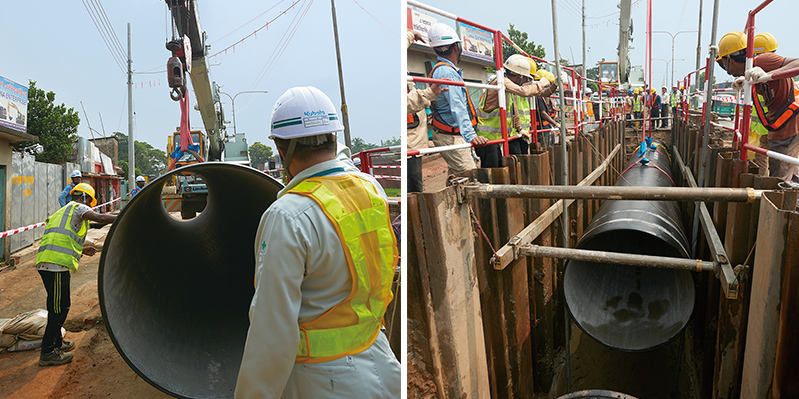
Pipes are carefully laid out one-by-one. Kubota also has unique knowhow in pipe connection.
Submitting a tender for a strict and fair international bidding Emphasizing high engineering prowess
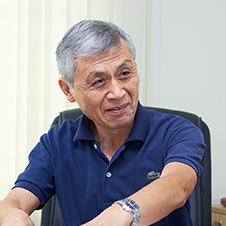
Executive Advisor NJS Consultants Co., Ltd.
Though the project was to be funded by the ODA, the JICA drew up a master plan with support from a consulting service (or an “engineer”). The responsibilities of such engineer would cover a broad spectrum, including creation of projects and discovery of issues, preparation and investigation, and both basic and detailed design. Other important responsibilities include selection of subcontracting construction companies and monitoring of construction work progress. Appointed to be engineer for the Karnaphuli Water Supply Project was NJS Consultants Co., Ltd. of Japan, which had experience in offering consulting services to water supply infrastructure projects around the world. It should be noted that it was not mandatory for NJS Consultants to subcontract the construction job of an ODA project to a Japanese company, despite it being funded by a yen loan, and instead a suitable construction company would be determined by a strict and fair international bidding. Thus, NJS Consultants’ task was to examine engineering capabilities and other parameters of construction services bidding from various countries and make a proper assessment.
“In any such project, the single most important thing is to pick a service that offers high engineering expertise and cost performance. Kubota Construction pointed out emphatically that this project would require a very high level of engineering, as pipework with large-diameter pipes involved extreme difficulty. It was also vital for the service to have everything needed to do the job. We, too, felt that Kubota Construction’s engineering technology stood out from the other bidders from various countries. Kubota Construction eventually made a successful bid, and we highly rate their construction work that followed, the progress of which earned our complete confidence.” (Takao Ochiai, Executive Advisor, NJS Consultants Co., Ltd.)
-
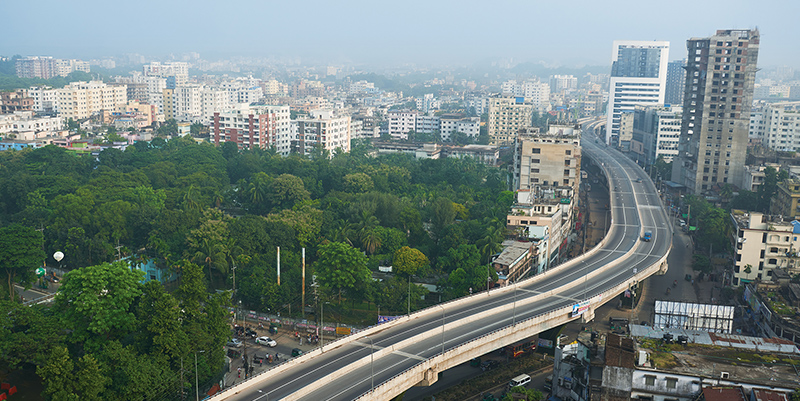
Elevated highway in Chattogram, underneath which water pipes run -
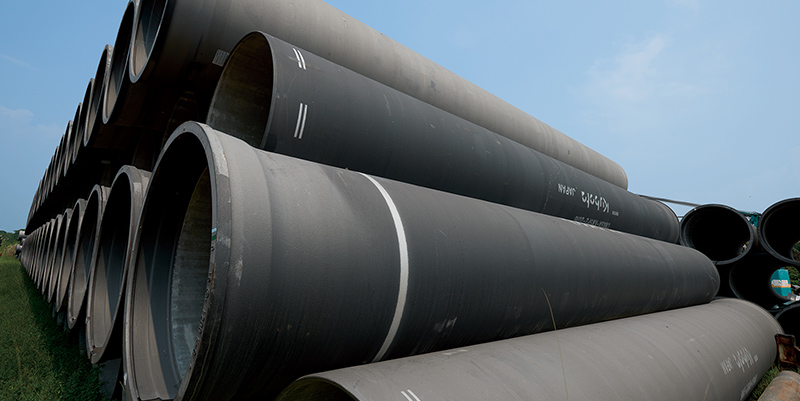
A ductile iron pipe for water supply (Chattogram, Bangladesh) -
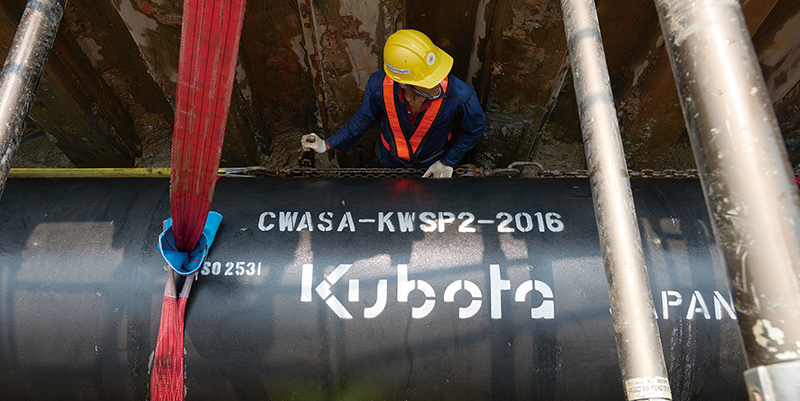
The Kubota brand earns immense credibility in Bangladesh.

